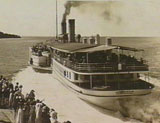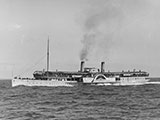Hygeia
![]() Wreck Dive |
Wreck Dive | ![]() Boat access
Boat access
![]()
![]()
![]()
![]()
![]()
Steel Passenger Paddle Steamer | Max Depth: 62 m (203 ft) — Graveyard
The Hygeia (aka PS Hygeia) is the shipwreck of a passenger paddle steamer, built in 1890 and after serving many years on Port Phillip, was scuttled 10 June 1932 in the Victorian Ships' Graveyard, Bass Strait.
Hygeia commenced service in 1890 as part of an expanding fleet of vessels catering to tourists in search of the fresh sea air and a pleasurable day outing on Port Phillip.
Diving the Hygeia Shipwreck
The Hygeia is not dived very often because its in the shipping channel. The feature of the dive is the paddle wheels, but it's also worth inspecting the stern section and the bow.
Bass Strait Warning: Always keep an eye on sea conditions throughout any shore or boat dive in Bass Strait on Victoria's coastline. Please read the warnings on the web page diving-in-bass-strait before diving or snorkelling this site.
Hygeia Shipwreck History — Built in 1890
The Hygeia was a steel paddle steamer of 986 tons gross, built in 1890, by Napier, Shanks & Bell, in Yoker (Glasgow), Scotland. The overall length of the vessel was 300 ft (91 m), with a beam of 32 ft (9.75 m) and a draught of 11.3 ft (3.44 m).
Her owners were the Bay Steamers Ltd, of Melbourne. A comfortable Port Phillip steamer, she could carry 1,600 passengers at speeds of up to 23 knots (43 kpm), with promenade decks, saloons, dining rooms, bars and a barber's shop. The Hygeia was generally regarded as one of the fastest and finest appointed paddle steamers ever built for Australian service.
The Hygeia left Greenoch, Scotland, on 21 August 1890, with a crew of 27, together with the first and second mates, under the coomand of Captain S. Patrick. Temporary bunks had been erected in the saloon to accommodate the crew. To nurse the engines, an easy speed of 12 knots (22 kpm) was adopted. The Hygeia made her way to Sydney via Lamlash, Kingstown, Queenstown, Gibralta, Malta, Port Said, Suez, Aden, Colombo, Batavia, Thursday Island and Brisbane. The voyage to Sydney took 86 days. The Hygeia soon left Sydney bound for Melbourne.
In December 1890, the PS Hygeia commenced passenger ferry services around Port Phillip.
The Hygeia went aground on Friday night, 22 December 1911 at Sorrento and was towed off on Saturday morning by the tug Nyorn. She was none the worse for this mishap and resumed her excursion running on Saturday.
Hygeia Sinking — Scuttled 10 June 1932
In May 1931, the Hygeia was sold to a ship-breaker from South Melbourne for approximately £600. The steamer was stripped of most items of value. Mr Morris the ship-breaker had contracted with the Melbourne Harbour Trust to dispose of the hull of the Hygeia in the Ship's Graveyard. As the tug Eagle was towing the Hygeia down Por Phillip, a strong northerly developed creating large waves. With the wind astern Hygeia began to lurch uncomfortably from side to side and when off St Leonards the towline snapped sending the Hygeia on a wild ride across Port Phillip. It only stopped when it grounded off Rosebud. Nearly 12 months later, on 7 June 1932, the hulk was refloated and taken across Port Phillip by the SS Rip and anchored off Swan Bay to await a suitable time to sink it.
On Friday 10 June 1932 the SS Rip tug took the hull of the Hygeia in tow and headed out into Bass Strait. The Hygeia was then scuttled shortly after 1 p.m. using explosive charges in the Victorian Ships' Graveyard.
The death struggles of the 40-year-old veteran were short given the gaping wound blown in her rusted plates. As the Hygeia plunged stern first to her last resting place the Bass Strait steamer Oonah piped a funeral blast on her siren.
See also, Heritage Council Victoria: Hygeia, and
Australian National Shipwreck Database: Hygeia.
Heritage Warning: Any shipwreck or shipwreck relic that is 75 years or older is protected by legislation. Other items of maritime heritage 75 years or older are also protected by legislation. Activities such as digging for bottles, coins or other artefacts that involve the disturbance of archaeological sites may be in breach of the legislation, and penalties may apply. The legislation requires the mandatory reporting to Heritage Victoria as soon as practicable of any archaeological site that is identified. See Maritime heritage. Anyone with information about looting or stolen artefacts should call Heritage Victoria on (03) 7022 6390, or send an email to heritage.victoria@delwp.vic.gov.au.
Finding the Hygeia Shipwreck
Over the years we've been provided with many GPS marks for the Hygeia. The GPS marks we know of in circulation for the Hygeia are:
- Book - Victoria's Ships' Graveyard GPS (verified):
Latitude: 38° 21.017′ S (38.350275° S / 38° 21′ 0.99″ S)
Longitude: 144° 33.633′ E (144.560548° E / 144° 33′ 37.97″ E) - Geoff Rodda:
Latitude: 38° 20.931′ S (38.34885° S / 38° 20′ 55.86″ S)
Longitude: 144° 33.715′ E (144.56191666667° E / 144° 33′ 42.9″ E)
198 m, bearing 36°, NE
Traditional Owners — This dive site does not lie in the acknowledged traditional Country of any first peoples of Australia.
Hygeia Location Map
Latitude: 38° 21.017′ S (38.350275° S / 38° 21′ 0.99″ S)
Longitude: 144° 33.633′ E (144.560548° E / 144° 33′ 37.97″ E)
Datum: WGS84 |
Google Map
Added: 2012-07-22 09:00:00 GMT, Last updated: 2022-05-14 12:03:12 GMT
Source: Book - Victoria's Ships' Graveyard GPS (verified)
Nearest Neighbour: Leeuwin, 346 m, bearing 127°, SE
Steel Passenger Paddle Steamer, 986 tons.
Built: Yorker (Glasgow), Scotland, 1890.
Scuttled: 10 June 1932.
Victorian Ships' Graveyard, Bass Strait.
Depth: 58 to 62 m.
[ Top ]
DISCLAIMER: No claim is made by The Scuba Doctor as to the accuracy of the dive site coordinates listed here. Should anyone decide to use these GPS marks to locate and dive on a site, they do so entirely at their own risk. Always verify against other sources.
The marks come from numerous sources including commercial operators, independent dive clubs, reference works, and active divers. Some are known to be accurate, while others may not be. Some GPS marks may even have come from maps using the AGD66 datum, and thus may need be converted to the WGS84 datum. To distinguish between the possible accuracy of the dive site marks, we've tried to give each mark a source of GPS, Google Earth, or unknown.





